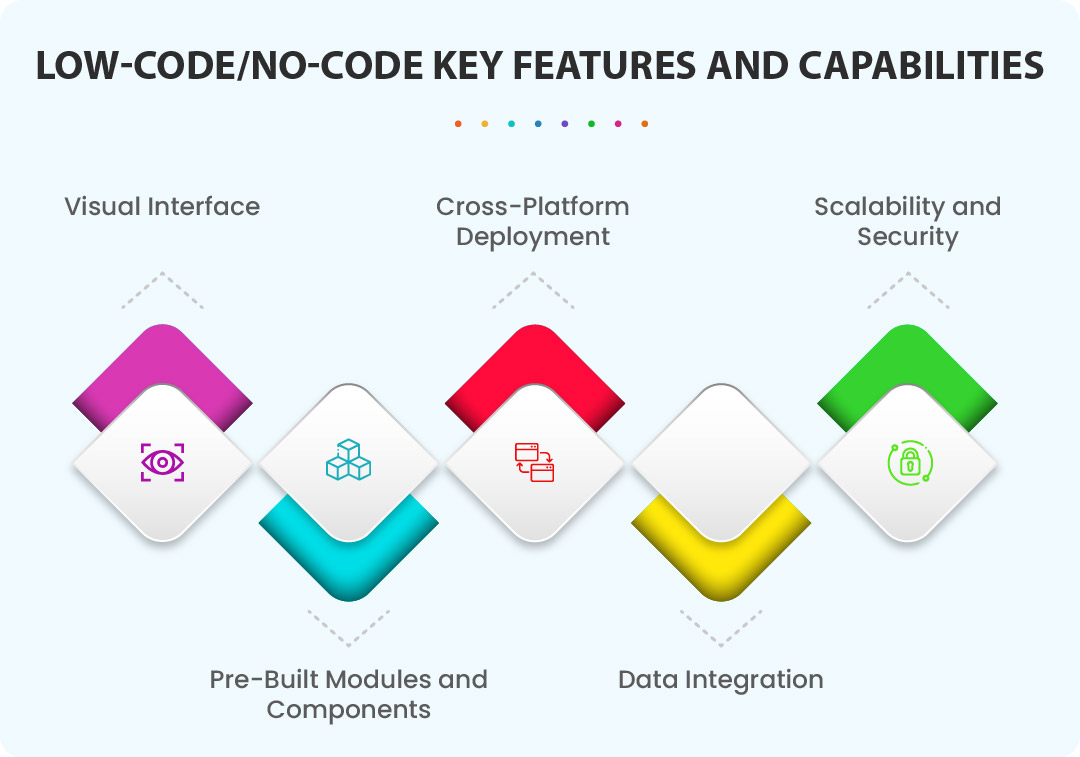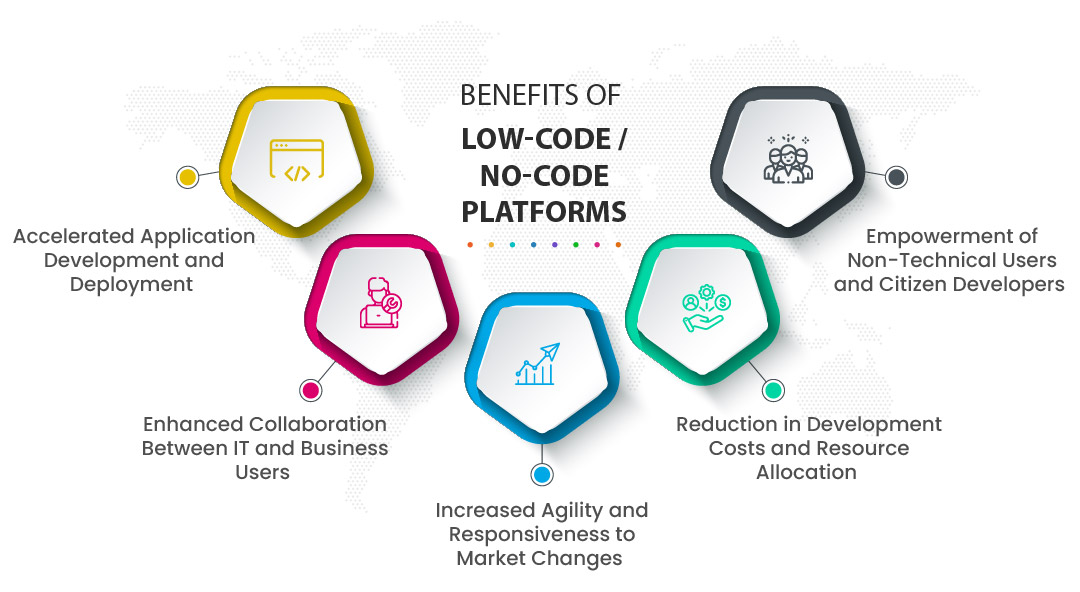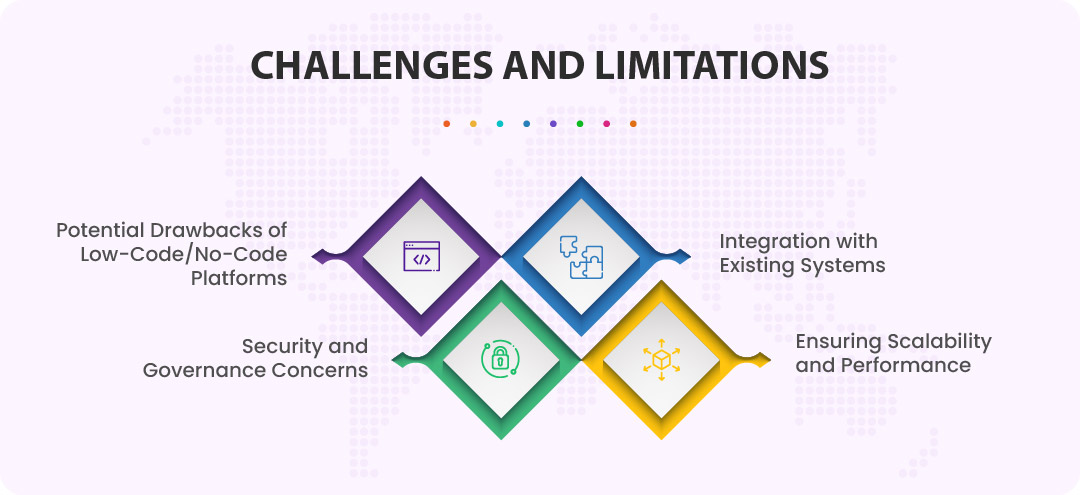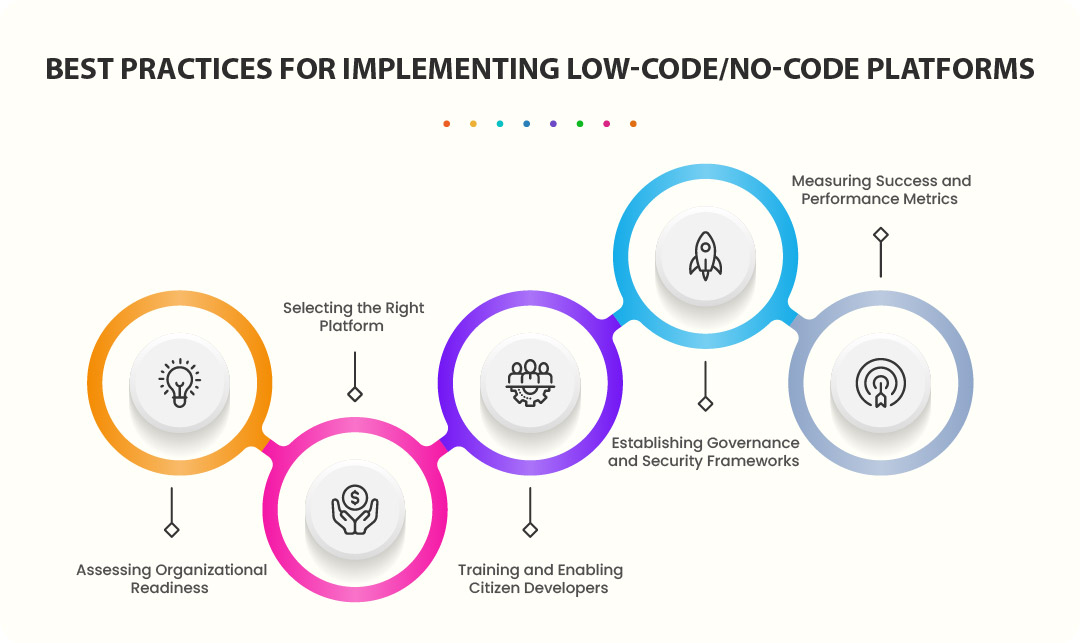Let's see the glimpse below,
- Introduction
- Understanding Low-Code/No-Code Platforms
- Enhancing Business Processes with Low-Code/No-Code Platforms
- Benefits of Low-Code/No-Code Platforms
- Case Studies
- Overcoming Challenges and Limitations of Low-Code/No-Code Platforms
- Best Practices for Implementing Low-Code/No-Code Platforms
- Conclusion
Introduction
In today’s rapidly evolving, tech-centric business landscape, digital transformation has moved beyond being a mere trend—it’s essential. As organizations work to keep pace with shifting market dynamics, customer expectations, and continual technological advancements, the imperative for digital transformation grows stronger. This shift is fundamentally altering how businesses function, engage with customers, and navigate competition. With the rise of digital-first strategies, companies across various sectors are realizing that embracing agile, technology-driven approaches is critical for sustainable growth, enhanced efficiency, and staying competitive.
Digital transformation is the process by which organizations integrate digital technologies into every aspect of their operations, fundamentally changing how they operate and deliver value to customers. This transformation is not limited to updating systems or adopting new tools; it encompasses a cultural shift that encourages innovation, optimizes processes, and leverages data-driven insights for informed decision-making. Essentially, digital transformation reimagines how businesses work, often reducing dependencies on manual processes and creating seamless digital workflows that enhance agility and resilience in a competitive landscape.
Importance of Digital Transformation in Today’s Business Landscape
The importance of digital transformation in the current business landscape cannot be overstated. In an era where speed, flexibility, and customer-centricity determine success, digital transformation enables companies to respond quickly to changing market conditions and customer expectations. Organizations that embrace digital transformation gain significant advantages, such as improved operational efficiency, cost savings, and enhanced customer experiences. Furthermore, by leveraging digital technology, businesses can uncover valuable insights through data analytics, enabling them to make proactive decisions and anticipate future trends. For industries facing disruption, digital transformation can be the key to survival, innovation, and long-term success, as it enables them to modernize outdated processes and harness new growth opportunities.
Overview of Low-Code/No-Code Platforms and Their Role in Digital Transformation
Low-code and no-code platforms are powerful enablers of digital transformation, especially for businesses seeking agility without the heavy investment in technical resources. These platforms allow users, regardless of technical expertise, to create applications and automate workflows through visual, drag-and-drop interfaces. By reducing the dependency on traditional software development, low-code/no-code platforms empower business users, also known as “citizen developers,” to create solutions tailored to their needs quickly. This democratization of app development accelerates innovation and allows for a faster response to changing business requirements.
In the context of digital transformation, low-code/no-code platforms play a pivotal role by enabling businesses to scale digital initiatives rapidly, iterate on new ideas, and optimize workflows without extensive coding expertise. They help bridge the gap between IT and business functions, enabling cross-functional teams to collaborate effectively and deploy digital solutions that align closely with organizational objectives. As digital transformation demands an agile and responsive approach, low-code/no-code platforms offer a pathway for businesses to innovate continuously, reduce operational bottlenecks, and achieve greater flexibility in a dynamic marketplace.
Understanding Low-Code/No-Code Platforms
Low-code and no-code platforms represent a significant shift in application development by simplifying the traditionally complex process of coding. They allow developers and non-developers alike to create software applications quickly, using visual interfaces, pre-configured components, and minimal to zero hand-coding.
- Low-Code Platforms: These platforms allow developers to build applications with minimal hand-coding by using drag-and-drop features, visual interfaces, and pre-built components. While low-code platforms reduce development time and lower complexity, some coding skills may still be required for more custom and intricate tasks. Low-code is ideal for professional developers seeking efficiency in building complex applications.
- No-Code Platforms: No-code platforms cater to non-developers, enabling them to create applications without writing any code. These platforms use intuitive interfaces, simple drag-and-drop tools, and automation to allow anyone, regardless of technical expertise, to create functional applications. No-code is designed for business users who need to develop solutions without relying on IT teams.
Key Features and Capabilities

- Visual Interface: Low-code and no-code platforms emphasize visual development to make app creation accessible and intuitive. Through drag-and-drop interfaces, users can design applications by selecting pre-built elements and arranging them visually, rather than writing code. Visual workflows further streamline the process, allowing users to create logic flows by connecting steps in a sequence, defining how an application behaves or responds to user actions. Additionally, model-driven development offers templates or pre-built models for common use cases, enhancing both ease of use and the speed of development.
- Pre-Built Modules and Components: These platforms come equipped with pre-configured modules, including basic user interface elements like buttons and forms, as well as more complex integrations, such as API connections or workflow automation tools. These components allow users to quickly assemble applications tailored to their needs, significantly reducing the time and complexity of app development. For businesses, this means faster prototyping and shorter deployment timelines, supporting rapid iteration.
- Cross-Platform Deployment: One of the strengths of low-code and no-code platforms is the ability to deploy applications across multiple platforms—web, mobile, and desktop—without requiring separate codebases. Users can create applications that adapt to various devices, enabling broader reach without additional development work.
- Data Integration: Effective data integration is essential for applications, allowing them to connect with external databases, APIs, or legacy systems. By facilitating smooth data flow between systems, these platforms help businesses create applications that align with their existing infrastructure.
- Scalability and Security: Business-critical applications built on low-code/no-code platforms require scalability to accommodate growing data, user numbers, or complex processes. Many platforms offer robust, enterprise-grade security features, such as data encryption, user access controls, and compliance with regulations like GDPR, ensuring applications can grow and remain secure as they scale.
Enhancing Business Processes with Low-Code/No-Code Platforms
Low-code/no-code platforms are transformative across multiple business functions, including project management, workflow management, marketing and sales, and customer support. Here’s how these platforms accelerate digital transformation within each area:
- Workflow Management: Automating workflows is essential for operational efficiency, and low-code/no-code platforms make this accessible. Teams can quickly design workflows that automate repetitive tasks, set up approval processes, and create seamless handoffs between departments. With visual workflow builders, users can optimize processes without needing coding expertise, increasing productivity and reducing bottlenecks.
- Marketing and Sales: Low-code/no-code platforms enable marketing and sales teams to create applications that enhance customer engagement and streamline lead management. Marketing teams can set up automated email campaigns based on customer actions, integrate CRM data for personalized outreach, and quickly test new campaigns. Sales teams benefit from automated lead scoring, tracking, and follow-up processes, helping them respond more effectively and improve conversion rates.
- Customer Support: Low-code/no-code platforms empower support teams to improve response times and customer satisfaction. They can build custom ticketing systems, automate ticket routing, and set up self-service options like FAQ portals and chatbots. With automation, support teams can reduce response times, prioritize urgent issues, and provide consistent service across channels, resulting in a better customer experience.
Benefits of Low-Code/No-Code Platforms

Accelerated Application Development and Deployment
Low-code and no-code platforms drastically reduce the time needed to build and deploy applications by simplifying complex coding tasks into drag-and-drop actions, templates, and pre-built components. With a visual development environment, both technical and non-technical users can quickly prototype, test, and launch applications. This faster time-to-market allows businesses to respond to opportunities or customer demands swiftly, often launching solutions within days rather than months.
Enhanced Collaboration Between IT and Business Users
Low-code and no-code platforms encourage closer collaboration between IT and business teams. By enabling business users to actively participate in the development process, these platforms help bridge the communication gap, allowing both sides to define requirements, customize workflows, and address specific pain points. IT professionals can focus on more complex tasks, while business users create applications that meet their immediate needs, resulting in solutions that align more closely with business goals.
Increased Agility and Responsiveness to Market Changes
In a rapidly changing market environment, businesses need the agility to adapt quickly. Low-code and no-code platforms allow organizations to update or modify applications as needed, with minimal development time. This flexibility enables businesses to quickly respond to market demands, adjust processes, or introduce new features, helping them stay competitive and relevant in the face of evolving industry trends.
Reduction in Development Costs and Resource Allocation
By simplifying and accelerating the development process, low-code and no-code platforms help reduce overall development costs. These platforms minimize the need for a large team of skilled developers, decreasing the resources and budget allocated to IT projects. As a result, companies can optimize their budgets, often achieving the same goals with fewer resources and reassigning their skilled developers to more strategic, high-impact projects.
Empowerment of Non-Technical Users and Citizen Developers
Perhaps one of the most transformative benefits of low-code and no-code platforms is their ability to empower non-technical users, often referred to as citizen developers. These platforms provide business users with the tools to create applications without coding knowledge, enabling them to take ownership of their processes and solve problems independently. This empowerment not only boosts employee engagement but also fosters a culture of innovation, as non-technical users can develop solutions directly aligned with their workflow needs, reducing the dependency on IT teams for every new solution.
Case Studies
Customer Relationship Management (CRM) with YoroCRM
Many organizations seek to enhance customer interactions and efficiently manage large volumes of client data. By implementing YoroCRM, they can customize their CRM systems to track leads, automate follow-up communications, and personalize customer engagement. This allows customer service representatives to quickly access comprehensive client histories, including relevant details and reminders.
Such customization can significantly improve customer retention and streamline the onboarding experience, as representatives can better address clients’ needs using historical data and personalized insights. The ease of customization offered by YoroCRM eliminates the need for extensive coding, saving time and resources, and enabling organizations to implement the solution swiftly—often in less than two months.
Business Process Automation with Yoroflow
Many organizations face challenges with repetitive, time-consuming tasks like client onboarding, document verification, and compliance checks. Using Yoroflow for business process automation, companies can streamline these workflows, reducing manual effort and processing times significantly. With Yoroflow’s user-friendly, drag-and-drop interface, teams can build workflows that automate essential tasks such as data entry, document handling, and real-time notifications.
For example, onboarding processes that previously took days can be automated with tasks like ID verification, background checks, and form completion seamlessly connected within the workflow. This automation reduces onboarding time by up to 60%, minimizes human errors, and allows employees to focus on more strategic, high-value work. Additionally, Yoroflow’s reporting and analytics tools enable organizations to monitor and optimize workflows continuously, enhancing both compliance and operational efficiency.
Enhancing Email Marketing with YoroConnect
Organizations looking to improve customer engagement can leverage YoroConnect to streamline their email marketing efforts. By utilizing automation features, businesses can set up triggers that respond to specific customer actions, such as recent purchases or abandoned shopping carts. YoroConnect’s integration capabilities allow companies to link their customer relationship management (CRM) data with email marketing tools, enabling the creation of dynamic and personalized email content tailored to individual customer preferences.
This approach can lead to significant increases in email open rates and conversion rates. By automating the email marketing process, organizations can ensure timely and relevant communication with customers, reducing the reliance on manual intervention from marketing teams and enhancing the overall effectiveness of their campaigns. YoroConnect empowers businesses to engage their customers more effectively and drive better marketing outcomes.
Improving Project Management with Yoroproject
Many software development companies face challenges in managing multiple client projects simultaneously, often resulting in missed deadlines and project scope creep. By implementing Yoroproject, organizations can centralize their project management tasks, allowing teams to effectively monitor progress, manage dependencies, and assign tasks with ease.
Yoroproject features visual dashboards that provide clear insights into project timelines, resource allocation, and budget status. Additionally, its task automation capabilities help streamline communication and maintain accountability among team members. As a result, companies may experience a significant reduction in project turnaround time and increased client satisfaction due to improved project visibility and timely delivery of results.
By leveraging Yoroproject, organizations can enhance their project management processes, foster better collaboration among team members, and ultimately achieve more successful outcomes for their clients.
Customer Support Management with YoroDesk
Organizations aiming to manage an increasing volume of customer inquiries often require a scalable solution to enhance their support operations. By implementing YoroDesk, companies can centralize and streamline their support management, addressing everything from ticketing to customer feedback.
YoroDesk features intuitive tools that enable businesses to set up automated workflows for assigning and escalating support tickets based on priority and response times. The platform also offers self-service options, such as Knowledgebase and automated responses, allowing customers to quickly find answers to their questions. This capability can significantly reduce the overall volume of support tickets.
With YoroDesk, support agents can resolve issues more efficiently, leading to faster resolution times and an overall improved customer experience. By optimizing support processes, organizations can ensure that customer inquiries are handled effectively, ultimately enhancing satisfaction and fostering customer loyalty.
Overcoming Challenges and Limitations of Low-Code/No-Code Platforms

While low-code and no-code platforms offer numerous benefits, they also come with potential drawbacks that organizations should be aware of as they implement these solutions.
Potential Drawbacks of Low-Code/No-Code Platforms
One significant drawback is the potential for limited customization. While these platforms provide user-friendly interfaces and pre-built components, they may not cater to all unique business needs, which could hinder innovation. Additionally, reliance on third-party platforms for critical business processes can raise concerns about vendor lock-in and dependency on the platform’s capabilities and future developments.
Security and Governance Concerns
Security is another critical concern, as low-code/no-code applications can introduce vulnerabilities if not managed properly. Organizations must ensure that these platforms comply with relevant regulations and standards, implementing proper governance to control user access and data management. Poorly managed applications can lead to data breaches or compliance violations, putting sensitive information at risk.
Integration with Existing Systems
Integrating low-code/no-code applications with existing legacy systems can also pose challenges. Organizations often have a mix of old and new technology and ensuring seamless communication between these systems requires careful planning and execution. Incompatibility issues may arise, making it difficult to share data and workflows across platforms.
Ensuring Scalability and Performance
Scalability is another vital consideration. While low-code/no-code platforms can speed up development, organizations must ensure that the applications can scale as the business grows. Performance issues may emerge when the application handles a higher volume of users or data, leading to slower response times and user dissatisfaction.
Best Practices for Implementing Low-Code/No-Code Platforms

Implementing low-code/no-code platforms can significantly enhance an organization’s agility and efficiency, but successful adoption requires careful planning and execution. Here are some best practices to consider:
1. Assessing Organizational Readiness
Before implementing a low-code/no-code platform, it’s essential to assess the organization’s readiness for such a change. This involves evaluating the current technology landscape, identifying existing skills among employees, and understanding the organization’s overall digital transformation goals. Consider conducting surveys or interviews with key stakeholders to gather insights on their expectations and potential challenges. Assessing readiness helps to identify gaps that may need addressing and ensures that the organization is well-prepared for the transition.
2. Selecting the Right Platform
Choosing the appropriate low-code/no-code platform is critical to successful implementation. Organizations should conduct a thorough evaluation of various platforms, considering factors such as functionality, ease of use, integration capabilities, scalability, and cost. It's also important to align the platform with specific business needs and workflows. Engaging with vendors to request demonstrations and trial periods can help organizations assess how well each platform meets their requirements before making a decision.
3. Training and Enabling Citizen Developers
Empowering citizen developers is a key aspect of maximizing the potential of low-code/no-code platforms. Organizations should invest in comprehensive training programs that cover not only the technical aspects of using the platform but also best practices for application development and project management. Providing access to resources such as tutorials, documentation, and community forums can further enhance user skills. Encouraging collaboration among citizen developers and IT professionals fosters a supportive environment where users feel confident to innovate.
4. Establishing Governance and Security Frameworks
Implementing robust governance and security frameworks is essential for managing risks associated with low-code/no-code platforms. Organizations should define clear policies and procedures that outline user roles, permissions, and data handling practices. Establishing a governance committee that includes representatives from IT, compliance, and business units can help oversee application development and ensure adherence to organizational standards. Additionally, implementing security measures, such as data encryption and regular audits, can protect sensitive information and maintain compliance with regulatory requirements.
5. Measuring Success and Performance Metrics
To gauge the effectiveness of low-code/no-code implementations, organizations should define success criteria and key performance indicators (KPIs) at the outset. Metrics may include application development time, user satisfaction, cost savings, and business outcomes such as increased efficiency or improved customer engagement. Regularly reviewing these metrics allows organizations to assess progress, identify areas for improvement, and celebrate successes. Feedback from users can provide valuable insights into the platform's effectiveness and inform future enhancements or training needs.
Conclusion
Low-code/no-code platforms have become pivotal in accelerating digital transformation, enabling organizations to respond rapidly to market demands, streamline operations, and foster innovation without requiring extensive coding expertise. By minimizing development complexity and empowering both technical and non-technical users, these platforms support faster application delivery, reduced costs, and increased operational efficiency. Platforms like Yoroflow exemplify this shift, offering intuitive drag-and-drop interfaces, pre-built modules, and extensive automation capabilities that help businesses quickly create customized solutions tailored to their unique needs.
Embracing low-code/no-code solutions like Yoroflow allows organizations to leverage the power of automation and data integration across departments—from customer relationship management to project management and beyond. With Yoroflow, teams can develop, modify, and deploy applications in days or weeks rather than months, facilitating agile responses to evolving business requirements.
As low-code/no-code technology advances, it will integrate with AI, IoT, and other emerging technologies, providing companies with even greater potential for data-driven insights and intelligent automation. By adopting these platforms, businesses position themselves for growth, resilience, and a competitive edge. In a digital-first era, embracing low-code/no-code solutions like Yoroflow are not only a strategic move but also a pathway to unlocking sustainable innovation and adaptability for the future.